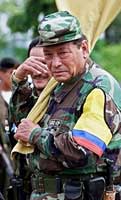FARC leader Manuel Marulanda, presente!
By
LeiLani Dowell
Published Jun 8, 2008 9:16 PM
People struggling for national liberation everywhere and workers throughout the
world lost a great leader with the death of Manuel Marulanda on March 26.
Marulanda, a founder of the Revolutionary Armed Forces of
Colombia—People’s Army (FARC-EP), was a skilled guerilla tactician
as well as a Marxist theorist. Put into practice, his efforts led to the
fruition of the largest and longest-lasting guerrilla movement in the Western
Hemisphere. Building this movement was Marulanda’s life work. His story
is the history of this struggle.
While the U.S. imperialist government with its allies in the Colombian
government and corporate media denounce the FARC as a so-called
“terrorist” organization, they ignore the terror inflicted on the
people of Colombia that provoked the creation of the FARC-EP in the first
place.
After rebellions followed the assassination of Liberal Party leader Jorge
Eliecer Gaitán on April 9, 1948, the Colombian government, led by the
Conservative Party, carried out mass violence against communists and members of
the Liberal Party. For ten years thereafter, a war between the two parties
spread throughout the country, with hundreds of thousands massacred.
No one was closer to the situation than Marulanda himself, and in
“Cuadernos de Campaña” (Campaign Notebooks), he describes the
beginnings of the armed resistance: “It was enough that a region or a
district was identified as having ‘communist’ or
‘collarejo’ residents for the police and the armed Conservatives to
destroy it, killing some of the inhabitants, burning their houses, taking
prisoners who never appeared again, stealing their livestock and raping women.
...
“[Resistance] groups made their appearance in the Cordillera Central with
many natural deficiencies at the beginning: inexperience, inadequate
organization, objective limitations, etc. For those condemned to death by the
chulavita death squads, they were something like a lifesaver. For the
peasants who did not want to continue on the unknown road of roaming to the
cities, temporarily or permanently abandoning the fruit of many years of hard
work, it was the hope of staying, participating and once in a while having a
glimpse of their native land to which they were so spiritually and materially
attached. ...
“Many groups organized themselves and dissolved. There was still the hope
among workers that the current situation was going to go away. But despite all
that, something remained solid: people ready to take all the implicit risks of
their decision to resist, and to transform that self-defense resistance into a
conscious mass attitude to achieve their goal so that future generations
didn’t have to experience the scourge of having guns in their hands.
These men and women have merited a place in the true ‘Homeland’s
History.’ They formed the nucleus of the determined struggle.”
The resolution of ten years known as “La Violencia” was a pact
known as a National Front, in which the nation’s presidency would switch
back and forth between the two parties for four presidential terms.
However, while the type of governance might have changed, the repression
against peasants and workers would only return and continue to this day.
Marulanda points out: “The bourgeoisie wisely knew how to take advantage
of these heroic struggles in order to take the leadership in overthrowing the
reactionary dictatorship of 1953 and to open a new chapter in governing. This
new chapter had slightly different characteristics, but was aimed at preserving
the same oligarchic and neocolonialist interests.”
After a Pentagon-inspired military incursion into several independently
governed peasant regions in 1964, the FARC set up camp in Riochiquito and
formally organized themselves.
Despite a concerted campaign by the Colombian government, backed by the U.S.
government to the tune of $600 million a year, the FARC has not disappeared.
Conversely, in the face of continued paramilitary massacres, the murder of
trade unionists and a general level of repression against all unarmed social
movements in Colombia, the FARC has continued its determined resistance against
imperialism. Meanwhile, the truth about corruption and murder at the hands of
the giant multinational corporations and the very heads of the Colombian
government steadily surface.
Marulanda notes several factors in the resilience of the FARC despite all odds.
In addition to truth, experience and solidarity, he states as the last factor:
“We are guided by a revolutionary ideology. Our political beacon is the
theory of socialism, shaped in the practice of communist activity.”
Workers and youth around the world owe a debt to and will be forever inspired
by Manuel Marulanda’s life of struggle and tenacity in the face of
overwhelming odds—proving once again that the power of the people can
repel the forces of oppression.
Long live the struggle of the Colombian people!
All the Marulanda quotes come from translations in the book “War in
Colombia: Made in U.S.A.,” available at leftbooks.com.
Articles copyright 1995-2012 Workers World.
Verbatim copying and distribution of this entire article is permitted in any medium without royalty provided this notice is preserved.
Workers World, 55 W. 17 St., NY, NY 10011
Email:
[email protected]
Subscribe
[email protected]
Support independent news
DONATE


